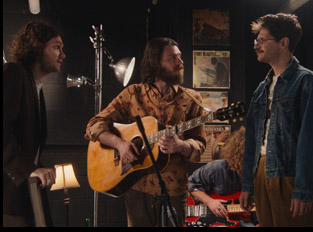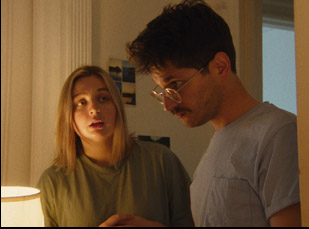Drew (Colin Burgess) is used to having the everything bagel in “Free Time,” part of a morning routine in where he is blissfully unconcerned with what his breakfast will cost or where he’s going when he’s on his way to a job in data analysis that will eat up the bulk of his day. He has aspirations of being a musician, but his band is on a break, so any time spent at work isn’t a burden and the steady job has brought stability in Brooklyn where he shares an apartment with a mellow roomie (Rajat Suresh) whose girlfriend (Holmes) only slightly gets on his nerves. It isn’t the life he necessarily wants, but one without much conflict until he realizes that the sight of one more spreadsheet will surely drive him up the wall.
As someone who is shown futzing over entry to the MTA turnstiles in the dazzling opening moments of Ryan Martin Brown’s disarming comedy as a pair of buskers find the right notes for his anxiety in the background, Drew is thrust into the unknown upon making an exit from the rat race, suddenly learning that even his everything bagel may be out of reach. (Ironically, it’s cheaper than the almond croissant he tries to treat himself too after leaving his job.) Although Brown may not have created a work of escapism when getting it all too right about the malaise that has set in amongst millennials who believe there has to be more to life than processing paperwork, “Free Time” nonetheless has an adventurous spirit, its lively energy emerging from being able to showcase all the suppressed aspirations of the artists working 9-to-5s it observes as Drew dares to head west, or at least as far as the West Village.
While Drew resists an offer to work in HR when there’s “more interaction with other people – and less pay,” Brown has clearly engaged an entire community to make “Free Time,” one of the first feature productions to emerge from the collective known as 5th Floor Pictures where an investment in the long haul amongst a number of filmmakers has allowed them to stretch time and resources in a way most individual productions can’t afford. Both amusing and accomplished, “Free Time” is making its way to theaters this week and Brown spoke about how he made the most of what he had at his fingertips, having a game co-conspirator with his leading man Burgess and how the film’s wild one-take opening title sequence in the subway system may have been one of the easiest scenes to film during the whole shoot.
I was spending a lot of time in previous years writing these movies that were thematically similar to this movie, but maybe a little too big to make and a little less direct. It was getting really frustrating, and they were all stories [about] some quest for freedom in some way, usually through a little bit more heightened scenarios, and it was hard to crack those scripts. At some point, I [thought] I’m just going to write the most direct version of this. There’s a guy who has a job, he doesn’t want it anymore, he gets out of it, he gets the freedom he wants, and then what does he do? So I wrote it with Colin in mind. We had worked together on a really small movie I had produced called “Yelling Fire in an Empty Theater,” and the title page of original draft of the script just said “Colin Quits His Job.” I just wrote it really fast as something that we weren’t really necessarily planning to make. It was just a distraction while we were trying to finish these bigger projects, but when it seemed like those weren’t going to happen, I talked with the group of collaborators I usually work with and we were like, “Should we just go do this one this fall?” And everyone said, “Yeah, okay, why not?”
When you’ve got a regular group of collaborators like that, particularly all these great musicians in the movie, how much do you actually build the narrative around what you know you have access to?
The writing process is each time you would get to a new scene, it’d be like, “Well, who do I know that would be fun to put in a movie?” And [for instance] having Michael Patrick Nicholson, an amazing musician, it was easy to just be like, “And then Michael walks in the room.” I don’t even think there were any character names in the original script. It was just literally “Michael Patrick Nicholson walks into the space,” and the whole movie was written out of what was available and who I thought would be great to work with.

Colin’s a really incredible performer, and most people in the movie are in the comedy world in one way or another, and it’s really amazing to work with comedians because they are so used to going on stage, trying a bit, being like, “Okay, that didn’t really work,” and then going back the next night, modulating a little bit, and [thinking] “That worked a little bit better,” so they all have this internal meter that when you’re kind of putting a scene together, obviously you’re giving some direction, but they really are trying to kind of twist and turn everything around where they can feel it work for themselves. Colin has an incredibly, incredibly sensitive meter in that way. You can throw anything at him, and you’ll watch him shift it around and find his way into it and how to make it work. That was such a gift on a movie where we were shooting so quickly that he was able to just show up, think about the scene, and find his way into it immediately. It was really incredible to watch.
You’re able to bring a lot of internal conflicts out, like the idea that the world is just passing this person by. Was that tricky to externalize?
That becomes another compliment to Colin’s performance as well, and what was slightly easier about writing this version of the movie than some of the other versions of the story that we’re working on is that Colin has an internal monologue that a lot of the time he’s just saying it out loud and he’s working through it. He’s got an incredible talent to make that feel natural and part of this person as opposed to someone who’s just delivering [exposition for] the audience. That was extremely helpful in terms of making that internal/external transfer clear.
Was the jazz piano in mind from the start as the musical accompaniment for this?
It was, and it came from the same place of working with what we knew we could do at a no-budget indie level. Normally, you hear some soundtracks and it’s like a single acoustic guitar and I feel like we had heard that a lot, but I was like, “Oh, we have this amazing friend Mason Margut,” who’s an amazing jazz pianist who plays around the city, and I [thought], “Well, we could still do a solo instrument and a very easy score, but what if it was Mason on the piano instead of the guitar?” He was amazing. He did pretty much the whole score before we even shot the movie. He would just sit at home and put his iPhone on the piano and we would talk about a few reference points, but he would just send me five minutes of him playing. And then Byron Leon, my editor, and myself, would just take the music and cut it up and we could edit the movie to all of Mason’s compositions that were ready, which was really hugely helpful.

It was really exciting to shoot. We were a little bit worried about getting shut down, but there’s something about having those two planes where you’re like, “Okay, the buskers are over here, and Colin’s over here, doing his business at the turnstiles,” and it just created a lot of freedom because [we let] Colin just go crazy and make stuff up and interact with real people who were coming through, and if we ever needed to just cut away, we’d [say] “Okay, now we go to the buskers.” So there was total freedom in the way that [scene] was set up, and it actually made that scene a little bit easier to do than some of the rest of the movie. We were also lucky to have Chloe and Patrick, who were killing it as the busker duo.
You also have a party in the film that really is brought to life by the roving camera and the environment where there’s this great cracked glass mirror. Was that something you brought in or found in a location?
It’s a big testament to Victor Ingles, our director of photography, and Alexandra Anez, who did the production design, and we didn’t really have a budget to dress anything from the ground up, and we didn’t really have the time to dramatically go in and alter a space, so the three of us would just have to go in anywhere and be like, “That’s interesting. If we just took this one thing from here and put it over there, that would work.” It was constraints to the extreme, but what was so great about working with them is that they were so fast. The second we walked into the apartment, they both were [drawn to] that mirror, so it was an exciting way to work, even if it was limiting in a lot of ways. People were also very generous. Our friends Rachel and Steven, whose apartment that is – if there wete amazing things to shoot in there, it’s because they’ve created an amazing space to live in, so a lot of it was just being very lucky to be allowed into people’s spaces like that.

With anything that you make yourself, I feel like sometimes it’s hard to go back and spend so much time with it once it’s done, but there are so many wonderful performers in the film. It is such a wide ensemble and not that there was a heavy amount of improv, but everyone brought some very creative ways to execute a scene, so it was a joy to just watch it each time and be like, “Oh man, I forgot the way that Bardia [Salimi] delivers this monologue when he’s screaming on the street. It’s crazy.” The joy of making a movie like this is hopefully you set up a playground for everyone and invite as many people in as you can and it is so much fun to look back and see what everyone brought to the space. That’s my favorite thing when I watch it again.
“Free Time” opens in New York on March 22nd at the Quad Cinema, March 29th in Los Angeles at the Landmark Westwood Theatre and April 12th in Chicago at the Gene Siskel Film Center.





